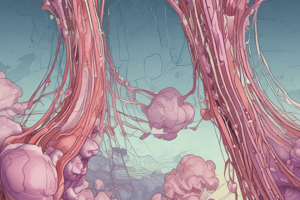Podcast
Questions and Answers
Which type of muscle tissue can be identified based on histological features?
Which type of muscle tissue can be identified based on histological features?
- Skeletal muscle
- Cardiac muscle
- Smooth muscle
- All of the above (correct)
What is the contraction mechanism of muscle tissue?
What is the contraction mechanism of muscle tissue?
- Actin and myosin sliding past each other (correct)
- Release of neurotransmitters
- Activation of calcium ions
- All of the above
Which textbook chapter(s) cover the topic of muscle tissue?
Which textbook chapter(s) cover the topic of muscle tissue?
- Junqueira's Basic Histology: Text and Atlas, 16e online: Muscle Tissue
- Both Weather's online and Junqueira's Basic Histology: Text and Atlas, 16e online (correct)
- Weather's online: Muscle Tissue
- Endocrine System
Which type of muscle is characterized by transverse lines that cross the fibers at irregular intervals and represent the interfaces between adjacent cells?
Which type of muscle is characterized by transverse lines that cross the fibers at irregular intervals and represent the interfaces between adjacent cells?
Which type of muscle is specialized for slow, steady contraction under the influence of autonomic nerves and various hormones?
Which type of muscle is specialized for slow, steady contraction under the influence of autonomic nerves and various hormones?
Which type of muscle lacks T-tubules and has rudimentary sarcoplasmic reticulum?
Which type of muscle lacks T-tubules and has rudimentary sarcoplasmic reticulum?
Which type of muscle has bundles of thin and thick myofilaments that crisscross the sarcoplasm obliquely?
Which type of muscle has bundles of thin and thick myofilaments that crisscross the sarcoplasm obliquely?
Which one of the following is NOT a function of muscle tissue?
Which one of the following is NOT a function of muscle tissue?
Which one of the following is a special name for the cell membrane and its external lamina in muscle tissue?
Which one of the following is a special name for the cell membrane and its external lamina in muscle tissue?
Which one of the following is a morphologic/histologic classification of muscle tissue?
Which one of the following is a morphologic/histologic classification of muscle tissue?
Which one of the following is responsible for the displacement of the nuclei against the sarcolemma in the development of skeletal muscle?
Which one of the following is responsible for the displacement of the nuclei against the sarcolemma in the development of skeletal muscle?
Which components make up the A band in skeletal muscle?
Which components make up the A band in skeletal muscle?
What is the function of the H zone in skeletal muscle?
What is the function of the H zone in skeletal muscle?
What is the role of the sarcoplasmic reticulum (SR) in skeletal muscle?
What is the role of the sarcoplasmic reticulum (SR) in skeletal muscle?
What is the function of Golgi tendon organs in muscles?
What is the function of Golgi tendon organs in muscles?
Flashcards are hidden until you start studying
Study Notes
Muscle Structure and Contraction Mechanism
- The molecular arrangement of myofibrils in skeletal muscle consists of thick (myosin) and thin (F-actin) filaments.
- The A bands contain thick filaments and overlapping portions of thin filaments, while the I bands consist of non-overlapping portions of thin filaments.
- The H zone is a lighter zone in the center of the A band, containing only the rodlike portions of the myosin molecule.
- The M line bisects the H zone and contains myomesin and creatine kinase.
- The sarcoplasmic reticulum (SR) surrounds the myofibrils and stores calcium ions.
- Transverse tubules (T-tubules) are tubular infoldings of the cell membrane that penetrate into the sarcoplasm, triggering calcium release from the SR.
- The triad is a complex of a T-tubule and two terminal cisternae of the SR.
- Muscle contraction occurs when thin and thick filaments slide past each other, triggered by the release of calcium ions from the SR.
- ATP hydrolysis provides energy for the myosin head pivot that pulls actin.
- Muscle spindles are stretch detectors located among the muscle fascicles, providing information about changes in muscle length to the spinal cord.
- Golgi tendon organs detect changes in tension within tendons and inhibit motor nerve activity if tension becomes excessive.
- Cardiac muscle cells form complex junctions and tightly knit bundles, allowing for a characteristic wave of contraction in the heart.
Studying That Suits You
Use AI to generate personalized quizzes and flashcards to suit your learning preferences.




